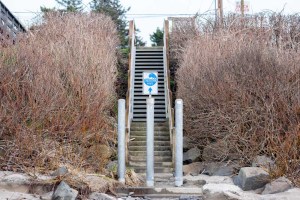Veterinary clinic on wheels
Published 4:00 am Sunday, January 30, 2011

- David Swendseid, who had Dr. Deborah Hodesson of All Pets Smiling Veterinary Care perform a root canal on his dog, Sage.
To get his dog Sage to her root canal appointment Wednesday, David Swendseid stepped out his front door, walked 40 feet and climbed into the mobile veterinary clinic parked at the curb.
Inside Dr. Deborah Hodesson’s 26-foot clinic, the anesthetized Czech German shepherd lay on the examination table, covered by a warming blanket, her tongue lolled out.
Trending
To prepare for the procedure, Hodesson and her assistant, Tiphane Townley, rolled up a dental cart, complete with drill, suction device, air and water. A beeping monitor kept tabs on Sage’s vital signs.
All Pets Smiling Veterinary Care’s mobile clinic also has a surgical suite, X-ray machine and sterilizing unit. In the future, it will have a blood-chemistry machine.
Historically, veterinarians traveled to treat their patients on location, and many still do, although determining how many can be difficult.
The American Veterinary Medical Society listed about 80,000 members as of Dec. 31, 2009, according to its Web page, but not how many consider themselves mobile or house-call veterinarians.
Of the 484 vets in the state listed on the Oregon Veterinary Medical Association’s website, 25 indicate a mobile clinic, five of them in Central Oregon.
Dr. Keri Lynne McDowell, who operates Sunshine Mobile Veterinary Services in Sisters with her husband, Dr. Greg Black, said some vets may have gone mobile to survive.
Trending
“The economy is down,” said McDowell, who previously had an office but now travels, working out of clients’ homes and area clinics for more complex procedures.
“A lot of the multidoctor practices have cut back. It’s harder to find work, and the market is pretty flooded. A lot are going to mobile (practices),” McDowell said.
McDowell and other veterinarians say a mobile practice brings care to animals whose owners cannot get to a brick-and-mortar office.
Hodesson, a veterinarian for more than 30 years, moved from clinic to full-time mobile practice Jan. 1. Her focus on animal dentistry, along with her custom-made clinic on wheels, sets All Pets Smiling Veterinary Care apart.
She’s the only vet in Central Oregon, she said, to perform advanced dentistry, such as root canals and periodontal surgery. She also preaches the importance of dental care for animals.
“I think dentistry is a basic thing that we’ve been neglecting for many years,” she said.
It’s also hard to miss the rolling clinic, its sides painted with orange and green waves and animal silhouettes, especially when parked at the curb in a residential neighborhood.
She will not perform chest surgeries or handle orthopedic problems. She does not work on horses, generally, although she will work on their teeth.
“About the only thing I don’t do is if someone is really, really sick, I (will treat them and take them to a hospital,)” she said. “I do anything from mice, hamsters, guinea pigs, dogs, cats and rabbits.”
Hodesson, a 1979 graduate of University of California, Davis, School of Veterinary Medicine, moved to Bend in fall 2006, selling her practice and leaving the state she had worked in for 27 years.
A competitive triathlete and master swimmer, Hodesson fell in love with Bend after visiting a friend. Discovering its reputation as a dog-crazy town also helped seal her decision.
“I sold my home, quit my job down there and moved up here,” she said.
It’s also where she met Tom Cary, who became her husband, while she was treating his dog.
Hodesson joined Central Oregon Veterinary Group, which she left in July. She also served as a fill-in, or relief, veterinarian, and professionally, she serves as a district representative of the Oregon Veterinary Medical Association and president of the Central Oregon Veterinary Medical Association.
Earlier in her career, Hodesson had a house-call practice, where the veterinarian travels to provide treatment but generally not in a fully outfitted clinic. Hitting the road again, she said, could help her fulfill several career goals.
It would give her more flexibility and increase the potential for treating animals whose owners, such as the elderly, cannot get to a clinic. She travels to retirement and assisted-living homes, treating residents’ pets.
Mobility also allows her to practice advanced dentistry.
Everything fell into place, she said, when La Boit Inc., an Ohio-based maker of mobile clinics, bloodmobiles and police command centers, let her know they had a repossessed vet clinic for sale with less than 10,000 miles.
Hodesson, 59, wants to become a board-certified veterinary dentist. She’s working in a residency program, which she expects will take six or seven years.
To gain experience, she also volunteers with the The Peter Emily International Veterinary Dental Foundation, which provides advanced dentistry for captive animals in sanctuaries and rescue facilities.
On missions with the foundation, Hodesson has pulled teeth, performed root canals and provided other treatment to chimps, bears, wolves ferrets, cougars, lions and tigers.
“I love wildlife, and I love fixing them up,” she said. “The big cats, I can just hold their paws and look at them. They are so beautiful.”
Her ultimate business goal: building up her practice enough to hire another veterinarian. She also hopes to educate clients and other veterinarians about dental care, along with treating the animals.
“One of my goals is to have everyone in Bend brushing their pets’ teeth every day,” she said.
When Hodesson attended veterinary school, students didn’t spend much time on dentisry, she said, but it’s important to animals, as it is for people. Untreated dental problems can lead to serious health issues and cause chronic pain.
Of the animals Hodesson treats, she said about 90 percent have dental problems. The American Veterinary Dental College backs her up, calling gum disease the most common problem in pets.
Dental work on animals can be expensive. A root canal can cost between $600 and $1,200, depending on the work involved.
But fixing teeth also can make a difference in pets’ behavior.
Hodesson has had clients who initially sought her help believing they would need to euthanize their pets because they appeared so ill.
But days after diagnosing and treating the pets’ dental problems, the owners call back asking for tranquilizers for the animals. Pain relief has left the pets bouncing around the house.
Dental problems also can be difficult to catch, without regular exams, Hodesson said. It took a teeth cleaning on her own dog, S’Kaana, a black Lab, for Hodesson to notice a broken tooth.
Spotting Sage’s broken canine tooth, which led to Wednesday’s root canal, was not difficult for Swendseid.
A dog trainer for 14 years, he noticed the problem during a training exercise, when Sage brought back a decoy weapon she retrieved from a fleeing suspect.
Having the root canal performed at the curb in front of his southeast Bend home made traveling and scheduling easier for Swendseid, who works full time in mental health intake and competes in tournament fishing, along with training dogs.
Being able to carry Sage into the van and lay her on the table also involved him in the process, he said.
“I feel better about it. I know that (she’s) right here,” he said, while standing on his lawn. “I know that this dog is going to be taken care of specifically, right now.”
Being trained as a potential security dog, Sage is not only a family pet, she’s also a potential business investment. The root canal keeps her healthy and protects that investment.
But Swendseid said he would have Sage treated, even if she was only a pet.
“If I could afford it, I would definitely do it,” he said.
Tim Doran can be reached at 541-383-0360 or at tdoran@bendbulletin.com.
To get his dog Sage to her root canal appointment Wednesday, David Swendseid stepped out his front door, walked 40 feet and climbed into the mobile veterinary clinic parked at the curb.
Inside Dr. Deborah Hodesson’s 26-foot clinic, the anesthetized Czech German shepherd lay on the examination table, covered by a warming blanket, her tongue lolled out.
To prepare for the procedure, Hodesson and her assistant, Tiphane Townley, rolled up a dental cart, complete with drill, suction device, air and water. A beeping monitor kept tabs on Sage’s vital signs.
All Pets Smiling Veterinary Care’s mobile clinic also has a surgical suite, X-ray machine and sterilizing unit. In the future, it will have a blood-chemistry machine.
Historically, veterinarians traveled to treat their patients on location, and many still do, although determining how many can be difficult.
The American Veterinary Medical Society listed about 80,000 members as of Dec. 31, 2009, according to its website, but not how many consider themselves mobile or house-call veterinarians.
Of the 484 vets in the state listed on the Oregon Veterinary Medical Association’s website, 25 indicate a mobile clinic, five of them in Central Oregon.
Dr. Keri Lynne McDowell, who operates Sunshine Mobile Veterinary Services in Sisters with her husband, Dr. Greg Black, said some vets may have gone mobile to survive.
“The economy is down,” said McDowell, who previously had an office but now travels, working out of clients’ homes and area clinics for more complex procedures.
“A lot of the multidoctor practices have cut back. It’s harder to find work, and the market is pretty flooded. A lot are going to mobile (practices),” McDowell said.
McDowell and other veterinarians say a mobile practice brings care to animals whose owners cannot get to a brick-and-mortar office.
Hodesson, a veterinarian for more than 30 years, moved from clinic to full-time mobile practice Jan. 1. Her focus on animal dentistry, along with her custom-made clinic on wheels, sets All Pets Smiling Veterinary Care apart.
She’s the only vet in Central Oregon, she said, to perform advanced dentistry, such as root canals and periodontal surgery. She also preaches the importance of dental care for animals.
“I think dentistry is a basic thing that we’ve been neglecting for many years,” she said.
It’s also hard to miss the rolling clinic, its sides painted with orange and green waves and animal silhouettes, especially when parked at the curb in a residential neighborhood.
She will not perform chest surgeries or handle orthopedic problems. She does not work on horses, generally, although she will work on their teeth.
“About the only thing I don’t do is if someone is really, really sick, I (will treat them and take them to a hospital),” she said. “I do anything from mice, hamsters, guinea pigs, dogs, cats and rabbits.”
Hodesson, a 1979 graduate of University of California, Davis, School of Veterinary Medicine, moved to Bend in fall 2006, selling her practice and leaving the state she had worked in for 27 years.
A competitive triathlete and master swimmer, Hodesson fell in love with Bend after visiting a friend. Discovering its reputation as a dog-crazy town also helped seal her decision.
“I sold my home, quit my job down there and moved up here,” she said.
It’s also where she met Tom Cary, who became her husband, while she was treating his dog.
Hodesson joined Central Oregon Veterinary Group, which she left in July. She also served as a fill-in, or relief, veterinarian, and professionally, she serves as a district representative of the Oregon Veterinary Medical Association and president of the Central Oregon Veterinary Medical Association.
Earlier in her career, Hodesson had a house-call practice, where the veterinarian travels to provide treatment but generally not in a fully outfitted clinic. Hitting the road again, she said, could help her fulfill several career goals.
It would give her more flexibility and increase the potential for treating animals whose owners, such as the elderly, cannot get to a clinic. She travels to retirement and assisted-living homes, treating residents’ pets.
Mobility also allows her to practice advanced dentistry.
Everything fell into place, she said, when La Boit Inc., an Ohio-based maker of mobile clinics, bloodmobiles and police command centers, let her know it had a repossessed vet clinic for sale with less than 10,000 miles.
Hodesson, 59, wants to become a board-certified veterinary dentist. She’s working in a residency program, which she expects will take six or seven years.
To gain experience, she also volunteers with the The Peter Emily International Veterinary Dental Foundation, which provides advanced dentistry for captive animals in sanctuaries and rescue facilities.
On missions with the foundation, Hodesson has pulled teeth, performed root canals and provided other treatment to chimps, bears, wolves ferrets, cougars, lions and tigers.
“I love wildlife, and I love fixing them up,” she said. “The big cats, I can just hold their paws and look at them. They are so beautiful.”
Her ultimate business goal: building up her practice enough to hire another veterinarian. She also hopes to educate clients and other veterinarians about dental care, along with treating the animals.
“One of my goals is to have everyone in Bend brushing their pets’ teeth every day,” she said.
When Hodesson attended veterinary school, students didn’t spend much time on dentistry, she said, but it’s important to animals, as it is for people. Untreated dental problems can lead to serious health issues and cause chronic pain.
Of the animals Hodesson treats, she said about 90 percent have dental problems. The American Veterinary Dental College backs her up, calling gum disease the most common problem in pets.
Dental work on animals can be expensive. A root canal can cost between $600 and $1,200, depending on the work involved.
But fixing teeth also can make a difference in pets’ behavior.
Hodesson has had clients who initially sought her help believing they would need to euthanize their pets because they appeared so ill.
But days after diagnosing and treating the pets’ dental problems, the owners call back asking for tranquilizers for the animals. Pain relief has left the pets bouncing around the house.
Dental problems also can be difficult to catch without regular exams, Hodesson said. It took a teeth cleaning on her own dog, S’Kaana, a black Lab, for Hodesson to notice a broken tooth.
Spotting Sage’s broken tooth, which led to Wednesday’s root canal, was not difficult for Swendseid.
A dog trainer for 14 years, he noticed the problem during a training exercise, when Sage brought back a decoy weapon she retrieved from a fleeing suspect.
Having the root canal performed at the curb in front of his southeast Bend home made traveling and scheduling easier for Swendseid, who works full time in mental health intake and competes in tournament fishing, along with training dogs.
Being able to carry Sage into the van and lay her on the table also involved him in the process, he said.
“I feel better about it. I know that (she’s) right here,” he said, while standing on his lawn. “I know that this dog is going to be taken care of specifically, right now.”
Being trained as a potential security dog, Sage is not only a family pet, she’s also a potential business investment. The root canal keeps her healthy and protects that investment.
But Swendseid said he would have Sage treated, even if she was only a pet.
“If I could afford it, I would definitely do it,” he said.
On the Web
• All Pets Smiling Veterinary Care can be reached via www.allpetssmiling.com.
• For information about oral care for pets, visit the American Veterinary Dental College at www.avdc.org.
• For information about products that help control dental plaque and tartar on pets’ teeth, visit the Veterinary Oral Health Council, an offshoot of the dental college, at www.vohc.org.
On the Web
• All Pets Smiling Veterinary Care can be reached via www.allpetssmiling.com.
• For information about oral care for pets, visit the American Veterinary Dental College at www.avdc.org.
• For information about products that help control dental plaque and tartar on pets’ teeth, visit the Veterinary Oral Health Council, an offshoot of the dental college, at www.vohc.org.








